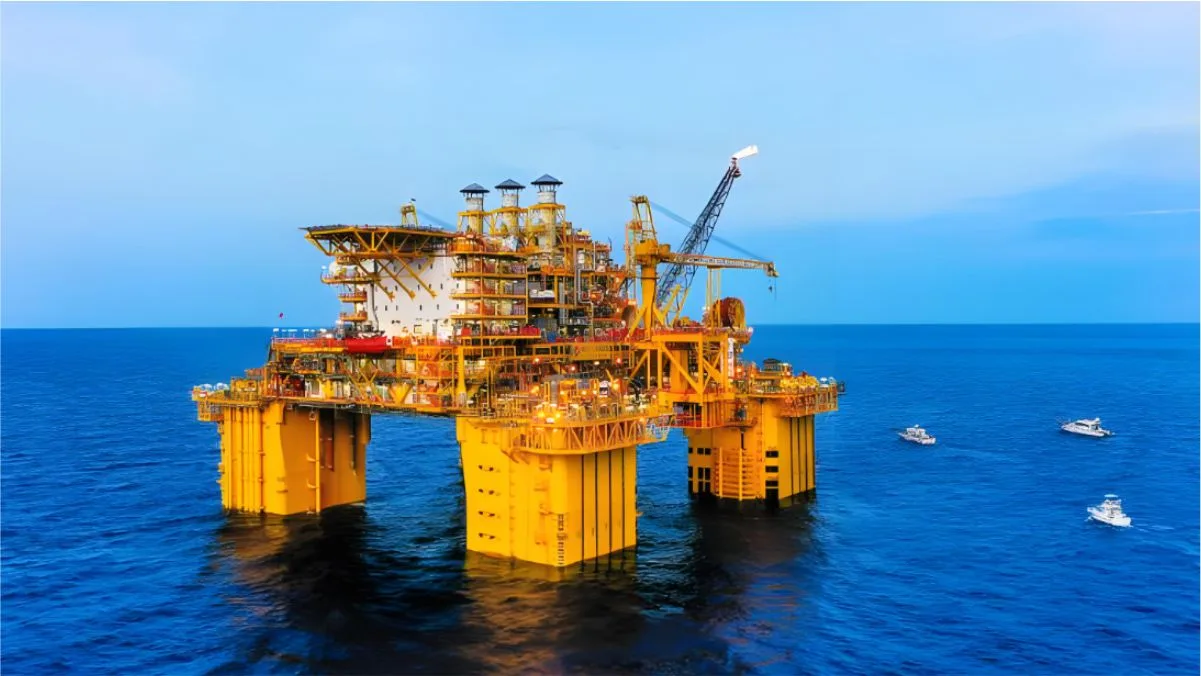
Corrosion-resistant alloy on the inside, high-strength steel on the outside — China’s bimetallic composite pipe breaks the monopoly and fortifies the “lifeline” for deep-sea oil and gas transmission.
At depths of 1,500 meters in the South China Sea, energy “arteries” are quietly stretching beneath the seabed. These pipelines carry high-temperature, high-pressure, and highly corrosive oil and gas flows, while enduring immense seawater pressure and erosion from the outside. Traditional carbon steel pipes survive only a few months under such harsh conditions, while fully nickel-based alloy pipes, though outstanding in performance, are prohibitively expensive.
In June 2025, Ansteel Group announced a breakthrough: in collaboration with domestic partners, they successfully developed a bimetallic composite pipe made from Inconel 625 nickel-based alloy + X65 pipeline steel, effectively solving this dilemma. This new pipe structure — “corrosion-resistant alloy lining + high-strength steel shell” — balances performance and cost, propelling China’s subsea pipeline technology to the forefront of global innovation.
01. The Dual Dilemma of Traditional Materials in Extreme Environments
As global energy demand rises, the exploration of oil and gas has moved from land to deep sea, and from conventional to extreme environments involving high temperatures, high pressures, and aggressive corrosion.
In deep-sea oil and gas development, pipelines face unprecedented challenges. Traditional carbon steel pipes rapidly degrade under the combined effects of corrosive media and high-pressure conditions. Corrosive agents such as chlorides, hydrogen sulfide, and carbon dioxide act as invisible assassins, relentlessly eroding the inner walls of pipelines.

Nickel-based alloy pipes offer superior corrosion resistance, but at a steep price — over ten times the cost of carbon steel. Using nickel alloys throughout an entire pipeline system would make deep-sea projects financially unfeasible.
The same challenges arise in nuclear power systems, where steam generator tubing must resist both high temperature and water corrosion; and in offshore platforms, where pipelines face seawater corrosion and wave-induced stress corrosion. These extreme conditions pose a tough question for material scientists: how can we strike the best balance between performance and cost?
02. Super Stainless Steel: A High-Performance, Cost-Effective Solution
To address this challenge, 254SMO super austenitic stainless steel, containing 6% molybdenum, emerged as a promising solution. Known for its excellent cost-performance ratio, 254SMO stands out in high-end pipeline applications.
Its premium chemical composition includes:
19.5–20.5% Chromium – for oxidation resistance,
6.0–6.5% Molybdenum – for outstanding pitting resistance,
17.5–18.5% Nickel – for stable austenitic structure,
0.18–0.22% Nitrogen – to significantly boost strength.
Its Pitting Resistance Equivalent Number (PRE) — a key corrosion resistance metric — exceeds 42.5, enabling strong defense against pitting and crevice corrosion in chloride-rich environments such as seawater. In some cases, it rivals more expensive alloys like Hastelloy C276 and titanium alloys.
254SMO has proven itself in various harsh environments:
Pulp bleaching lines, resisting both acidic and oxidizing halide solutions;
Seawater desalination plants, serving in cooling water and ballast systems;
Flue gas desulfurization units, confronting corrosive agents directly.
Suppliers emphasize one thing: “Cost-effectiveness!” Compared to traditional nickel alloys, 254SMO delivers similar corrosion resistance at a significantly lower price, making it a practical alternative in demanding conditions.
Key performance parameters of 254SMO stainless steel:
| Performance Metric | Value |
| Tensile Strength | ≥ 650 MPa |
| Yield Strength | ≥ 310 MPa |
| Elongation | ≥ 40% |
| PRE (Pitting Resistance) | ≥ 42.5 |
| Density | 8.0 g/cm³ |

03. The “Three Musketeers” of Nickel-Based Alloys
When even super stainless steels fall short, nickel-based alloys take the stage. In high-temperature, high-pressure, and high-corrosion settings such as deep-sea pipeline connectors and nuclear steam generator tubing, Inconel 625 and Monel 400 offer irreplaceable value.
Inconel 625: Guardian of the Deep Sea and Nuclear Sector
This nickel-chromium alloy is masterfully formulated:
62% Nickel – for structural stability,
22% Chromium – for oxidation resistance,
9% Molybdenum – to resist chloride attack,
3.7% Niobium – to strengthen through solid solution hardening.
In shipbuilding, Inconel 625 is ubiquitous — from seawater cooling and fire-fighting systems to hydraulic and instrumentation lines. It withstands long-term seawater exposure and high mechanical stress.
In nuclear power plants, it serves in steam generator tubing operating continuously at 300–600°C, resisting hot water corrosion and radiation. Tests show its corrosion resistance in gas desulfurization environments rivals titanium and Hastelloy C-276.

Monel 400: Champion of Reducing Environments
If Inconel 625 dominates oxidizing conditions, Monel 400 — with over 63% nickel — reigns in reducing ones.
It remains stable in sulfuric acid (<85% concentration);
Outperforms most stainless steels in hydrochloric acid;
Excels in high-temperature sulfur-rich environments in crude distillation units;
In the nuclear industry, it withstands uranium refining and isotope separation.
Notably, Monel 400 thrives in seawater systems, used in pump shafts and propellers where it resists cavitation and corrosion under high-speed rotation. Its ductility and thermal conductivity also make it ideal for steam systems in power plants.
Incoloy 825: Specialist in H₂S Resistance
As a key member of the nickel alloy family, Incoloy 825 (with ~40% nickel) excels against hydrogen sulfide stress corrosion. Northeastern University in China developed 825/X65 bimetallic plates for pipelines between China and Turkmenistan, designed specifically to combat H₂S corrosion.
In environments containing H₂S, chlorides, and alkali metals, it resists pitting, intergranular corrosion, and stress corrosion cracking — ideal for high-sulfur oil and gas fields. When combined with carbon steel, it delivers excellent performance while slashing costs.
04. Bimetallic Composite Design: The Art of Balance
Single-material systems have inherent limitations. To overcome them, scientists introduced a revolutionary solution — bimetallic composite technology. With a “corrosion-resistant alloy interior + structural steel exterior,” this innovation perfectly balances performance and cost.
In 2015, Northeastern University’s RAL lab successfully produced 825/X65 bimetallic composite plates at Nanjing Steel. The inner 825 layer provides corrosion resistance, while the outer X65 ensures structural strength and affordability.
A decade later, Ansteel took this further by developing Inconel 625 + X65 composite pipes. The inner Inconel 625 layer (1–3mm thick) faces the corrosive medium; the outer X65 layer (20–30mm thick) bears the load.
Overcoming technical hurdles in bimetallic plate production, Ansteel leveraged its advanced metallurgy capabilities to ensure the composite met all specifications. The result? A 70–80% reduction in corrosion alloy usage and over 50% cost savings — all while ensuring 25+ years of deep-sea pipeline service life.

05. The Craft of Shaping Challenging Materials
High-performance alloys are notoriously difficult to process due to low thermal conductivity, high chemical reactivity, hardness, and low elasticity. Engineers often consider them “difficult-to-machine materials.”
Nickel-based alloys like Inconel 718, 625, and Monel 400 suffer severe work hardening during machining. This leads to high cutting forces, rapid tool wear, poor surface quality, and high costs.
Hot machining techniques offer a solution. Studies show that machining nickel alloys at 300–600°C:
Reduces cutting forces by 30–40%,
Cuts tool wear by over 30%,
Improves surface finish,
Extends tool life by 2–3 times.
Flame heating, using propane-oxygen combustion, preheats the workpiece to ideal cutting temperatures, reducing shear strength and avoiding cold or strain hardening.
Processing 254SMO also requires special techniques:
Its high yield strength demands stronger forming forces,
Welding requires specific filler metals (e.g., ERNiCrMo-3),
Hot working must be strictly controlled between 1800–2100°F to avoid oxide scaling.
Material scientists emphasize: “Processing technology is as critical as alloy formulation. Only through precise manufacturing can the full potential of high-end materials be unleashed.”
06. The Road Ahead: The Future of High-End Pipelines
As China’s deep-sea development and energy security strategies advance, high-end pipeline materials face unprecedented opportunities.
Multifunctional composite pipelines are a hot research area. Scientists are exploring smart systems that integrate sensors, self-healing layers, anti-corrosion coatings, and base materials to enable condition awareness, self-protection, and performance tuning.
Materials genome engineering is accelerating alloy development by simulating performance under specific corrosion conditions. Alloys resistant to H₂S + CO₂ + Cl⁻ triple threats will solve complex deep-sea transport challenges.
Green manufacturing is another focus. Traditional energy-intensive nickel alloy smelting is giving way to vacuum melting and additive manufacturing (3D printing), enabling precise fabrication of complex parts with minimal waste.

Industry experts predict: “In the next decade, China will evolve from a follower to a leader in high-end pipeline materials. With a mature supply chain and technological breakthroughs, more ‘Made in China’ innovations will go global.”
After ten years of dedicated research, Ansteel’s team has mastered vacuum roll bonding technology. With bimetallic pipes now extending into the South China Sea, China has secured a domestically developed “vascular system” for subsea energy transport.
On a Bohai Bay offshore platform, engineers inspect newly installed systems. Seawater cooling pipes made from 254SMO glisten under the sun; the joints feature Inconel 625 corrosion-resistant fittings, while the main subsea pipelines are forged from the newly developed bimetallic composites.
Materials science has no end — only the next extreme to conquer. As humanity reaches deeper, hotter, and harsher realms, the next generation of alloys is already quietly taking shape in the lab.
